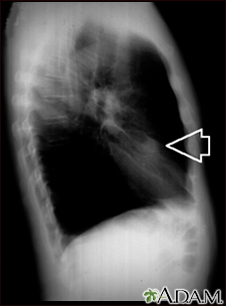Chest x-ray
Chest radiography; Serial chest x-ray; X-ray - chest
A chest x-ray is an x-ray of the chest, lungs, heart, large arteries, ribs, and diaphragm.
Images


















How the Test is Performed
You stand in front of the x-ray machine. You will be told to take a breath in and hold it when the x-ray is taken.
Two images are usually taken. You will first need to stand facing the machine, and then sideways.
How to Prepare for the Test
Tell your health care provider if you are pregnant. Chest x-rays are generally avoided during pregnancy, and special precautions are taken if they are needed.
How the Test will Feel
There is no discomfort. The imaging plate may feel cold.
Why the Test is Performed
Your provider may order a chest x-ray if you have any of the following symptoms:
- A persistent cough
- Chest pain from a chest injury (with a possible rib fracture or lung complication) or from heart problems
- Coughing up blood
- Difficulty breathing
- Fever
It may also be done if you have signs of tuberculosis, lung cancer, or other chest or lung diseases.
A serial chest x-ray is one that is repeated. It may be done to monitor changes found on a past chest x-ray.
What Abnormal Results Mean
Abnormal results may be due to many things, including:
In the lungs:
- Collapsed lung
- Collection of fluid around the lung
- Lung tumor (noncancerous or cancerous)
- Malformation of the blood vessels
- Pneumonia
- Scarring of lung tissue
- Tuberculosis
- Atelectasis
In the heart:
- Problems with the size, position or shape of the heart
- Problems with the position, size and shape of the large arteries
- Evidence of heart failure
In the bones:
- Fractures or other problems of the ribs and spine
- Osteoporosis
In the mediastinum (middle part of the chest):
- Enlargement, which might be related to infection or tumor
Risks
There is low radiation exposure. X-rays are monitored and regulated to provide the minimum amount of radiation exposure needed to produce the image. Most experts feel that the benefits outweigh the risks. Pregnant women and children are more sensitive to the risks of x-rays.
Related Information
X-rayCoughing up blood
Chest pain
Pulmonary tuberculosis
Lung cancer - small cell
Lung disease
Collapsed lung (pneumothorax)
Pleural effusion
Cerebral arteriovenous malformation
Community-acquired pneumonia in adults
Osteoporosis
Broken bone
Achalasia
Heart attack
Acute mountain sickness
Simple pulmonary eosinophilia
Adult Still disease
Alpha-1 antitrypsin deficiency
Anthrax
Aortic dissection
Aortic regurgitation
Aortic stenosis
Acute respiratory distress syndrome
Asbestosis
Aspergillosis
Aspiration pneumonia
Atelectasis
Atrial septal defect (ASD)
Atypical pneumonia
Blastomycosis
Breast cancer
Asthma
Bronchiectasis
Bronchiolitis
Bronchopulmonary dysplasia
Byssinosis
Rheumatoid pneumoconiosis
Cardiac tamponade
Brain abscess
Coal worker's pneumoconiosis
Coarctation of the aorta
Diaphragmatic hernia
Interstitial lung disease
Dilated cardiomyopathy
Disseminated tuberculosis
Drug-induced lupus erythematosus
Drug-induced pulmonary disease
Echinococcosis
Empyema
Anti-glomerular basement membrane disease
Heart failure
Histoplasmosis - acute (primary) pulmonary
Hodgkin lymphoma
Hospital-acquired pneumonia
Hypersensitivity pneumonitis
Hypertensive heart disease
Hypertrophic cardiomyopathy
Hypothyroidism
Idiopathic pulmonary fibrosis
Industrial bronchitis
Legionnaires disease
Malignant hypertension
Meningitis
Solitary fibrous tumor
Malignant mesothelioma
Metastatic brain tumor
Lung metastases
Metastatic pleural tumor
Mitral valve regurgitation
Mitral stenosis
Mitral valve prolapse
Mycoplasma pneumonia
Myocarditis
Necrotizing vasculitis
Neuroblastoma
Neurosarcoidosis
Non-Hodgkin lymphoma
Occupational asthma
Patent ductus arteriosus
Pericarditis
Pericarditis - after heart attack
Peripartum cardiomyopathy
Pneumocystis jirovecii pneumonia
Pneumonia - weakened immune system
Premature infant
Primary alveolar hypoventilation
Pulmonary hypertension
Pulmonary actinomycosis
Pulmonary alveolar proteinosis
Pulmonary aspergilloma
Pulmonary edema
Pulmonary embolus
Histiocytosis
Pulmonary nocardiosis
Pulmonic valve stenosis
Pulmonary veno-occlusive disease
Q fever
Renal cell carcinoma
Neonatal respiratory distress syndrome
Respiratory syncytial virus (RSV)
Restrictive cardiomyopathy
Rheumatoid lung disease
Sarcoidosis
Cardiac amyloidosis
Silicosis
Solitary pulmonary nodule
SVC obstruction
Systemic lupus erythematosus
Scleroderma
Testicular cancer
Tetralogy of Fallot
Transient ischemic attack
Transposition of the great arteries
Ventricular septal defect
Viral pneumonia
Granulomatosis with polyangiitis
Wilms tumor
References
Felker GM, Teerlink JR. Diagnosis and management of acute heart failure. In: Libby P, Bonow RO, Mann DL, Tomaselli GF, Bhatt DL, Solomon SD, eds. Braunwald's Heart Disease: A Textbook of Cardiovascular Medicine. 12th ed. Philadelphia, PA: Elsevier; 2022:chap 49.
Jokerst CE, Gotway MB. Thoracic radiology: noninvasive diagnostic imaging. In: Broaddus VC, Ernst JD, King TE, et al, eds. Murray and Nadel's Textbook of Respiratory Medicine. 7th ed. Philadelphia, PA: Elsevier; 2022:chap 20.
Nair A, Barnett JL, Semple TR. Current status of thoracic imaging. In: Adam A, Dixon AK, Gillard JH, Schaefer-Prokop CM, eds. Grainger & Allison's Diagnostic Radiology. 7th ed. Philadelphia, PA: Elsevier; 2021:chap 1.
BACK TO TOPReview Date: 8/19/2024
Reviewed By: Allen J. Blaivas, DO, Division of Pulmonary, Critical Care, and Sleep Medicine, VA New Jersey Health Care System, Clinical Assistant Professor, Rutgers New Jersey Medical School, East Orange, NJ. Review provided by VeriMed Healthcare Network. Also reviewed by David C. Dugdale, MD, Medical Director, Brenda Conaway, Editorial Director, and the A.D.A.M. Editorial team.

Health Content Provider
06/01/2025
|
A.D.A.M., Inc. is accredited by URAC, for Health Content Provider (www.urac.org). URAC's accreditation program is an independent audit to verify that A.D.A.M. follows rigorous standards of quality and accountability. A.D.A.M. is among the first to achieve this important distinction for online health information and services. Learn more about A.D.A.M.'s editorial policy, editorial process and privacy policy. A.D.A.M. is also a founding member of Hi-Ethics. This site complied with the HONcode standard for trustworthy health information from 1995 to 2022, after which HON (Health On the Net, a not-for-profit organization that promoted transparent and reliable health information online) was discontinued. |
The information provided herein should not be used during any medical emergency or for the diagnosis or treatment of any medical condition. A licensed medical professional should be consulted for diagnosis and treatment of any and all medical conditions. Links to other sites are provided for information only -- they do not constitute endorsements of those other sites. © 1997- 2025 A.D.A.M., a business unit of Ebix, Inc. Any duplication or distribution of the information contained herein is strictly prohibited.
